God and Cosmos
A Christian View of Time, Space, and the Universe
Out of stock
| Weight | 0.32 kg |
|---|---|
| Dimensions | 21.5 × 13.6 × 2.0 cm |
| ISBN | 9780851518008 |
| Binding | Paperback |
| Format | Book |
| Page Count | 256 |
| Original Pub Date | 2001 |
| Banner Pub Date | Apr 20, 2001 |
Book Description
In his book A Brief History of Time, the famous Cambridge cosmologist Stephen Hawking held out the prospect of a complete theory of the universe by means of which we would know ‘why it is that we and the universe exist…then we would know the mind of God.’ Christian mathematician John Byl disagrees: ‘Hawking overestimates the value of a Theory-of-Everything, while underestimating the content of God’s mind.’ We already have in Scripture a source of knowledge superior to all other sources and already know ‘the mind of God’. so far as He has been pleased to reveal it to us. On this basis, Byl questions much of modern cosmology, including the Big-Bang theory of origins. He deals with the limitations of human knowledge, biblical teaching relevant to cosmology, the quest for extra-terrestrial intelligence, the existence of the spiritual realm, heaven, angels, life after death, and much else. Byl’s approach is a refreshing counter to the dreary and ultimately meaningless outlook of modern cosmology.
Table of Contents Expand ↓
| Preface | xi | |
| 1 | THE BASIC QUESTIONS | |
| Reconciling Cosmology and the Bible | 2 | |
| Evaluating Cosmological Models | 2 | |
| The Role of Religious Commitments | 5 | |
| Epistemology and Revelation | 6 | |
| Interpreting the Bible | 9 | |
| The Scope of Biblical Authority | 11 | |
| Preview | 13 | |
| 2 | A BRIEF HISTORICAL SKETCH | |
| Ancient Cosmology | 15 | |
| Origins of Greek Cosmology | 16 | |
| Classic Cosmology | 17 | |
| Saving the Phenomena | 19 | |
| Medieval Cosmology | 22 | |
| The Perfect Harmony | 22 | |
| The Demise of Medieval Cosmology | 26 | |
| Galileo versus the Church | 27 | |
| Theological Consequences | 32 | |
| Pre-Modern Cosmology | 35 | |
| Newtonian Cosmology | 35 | |
| The Dynamic Universe | 38 | |
| Heat Death | 39 | |
| 3 | MODERN COSMOLOGY | |
| A Brief History of the Big Bang | 42 | |
| Explaining the Observations | 48 | |
| 1. Red Shifts | 49 | |
| 2. Abundances of Elements | 53 | |
| 3. The Cosmic Microwave Background | 55 | |
| Further Big Bang Problems | 59 | |
| 1. Inflation | 61 | |
| 2. Galaxy Formation | 62 | |
| 3. Missing Mass | 63 | |
| 4. Acceleration | 64 | |
| 5. More Puzzles | 65 | |
| Basic Cosmological Assumptions | 66 | |
| The Problem of Verification | 71 | |
| 4 | COSMOLOGY AND GOD’S EXISTENCE | |
| The Cosmological Argument | 77 | |
| Philosophical Arguments | 78 | |
| The Big-Bang Singularity | 82 | |
| The Second Law of Thermodynamics | 92 | |
| The Argument from Design | 96 | |
| Alternatives to Design | 99 | |
| Design and Evolution | 108 | |
| Conclusions | 108 | |
| 5 | COSMOLOGY, LIFE AND THE FUTURE | |
| Life in the Universe | 113 | |
| A Brief History of ETI | 114 | |
| The Scientific Case for ETI | 115 | |
| Motivation for Belief in ETI | 119 | |
| Theological Considerations | 120 | |
| The Future of Life in the Universe | 125 | |
| Future Life in a Closed Universe | 127 | |
| Future Life in an Open Universe | 128 | |
| Future Life in a Plasma Cosmology | 130 | |
| 6 | THE STRANGE GODS OF MODERN COSMOLOGY | |
| The Evolving God of Natural Theology | 133 | |
| Natural Evolving Gods | 134 | |
| Self-Caused Gods | 139 | |
| An Evolving God and Christianity | 144 | |
| 1. The God of Teilhard de Chardin | 144 | |
| 2. The God of Process Theology | 146 | |
| Life After Death | 149 | |
| 7 | THE BIBLE ON COSMOLOGY | |
| The Being and Nature of God | 153 | |
| The Doctrine of Creation | 156 | |
| The History of the Universe | ||
| Creation Events | 159 | |
| The Fall and Its Consequences | 163 | |
| Eschatology | 164 | |
| The Date of Creation | 165 | |
| The Spiritual Realm | 167 | |
| Further Cosmological Questions | ||
| The Stars as Signs | 172 | |
| The Size of the Universe | 178 | |
| An Expanded Universe? | 179 | |
| The Biblical Frame of Reference | 180 | |
| The Big Bang and the Bible | 181 | |
| 8 | BIBLICAL COSMOLOGIES | |
| Young Universes | ||
| 1. A Variable Speed of Light | 189 | |
| 2. Time Dilation | 192 | |
| 3. Curved-Space Models | 193 | |
| 4. Mature Creation | 194 | |
| Geometric Models | 202 | |
| Limits of Biblical Cosmology | 209 | |
| 9 | CONCLUSIONS | |
| Summary | 215 | |
| Final Concluding Remarks | 221 | |
| Bibliography | 226 | |
| Index of Names and Subjects | 238 | |
| FIGURES | ||
| 2.1 | The Geocentric Universe according to Peter Apian | 18 |
| 2.2 | Epicyclic Theory | 21 |
| 2.3 | The Medieval View of the Universe | 23 |
| 2.4 | Dante’s Conception of the Universe | 25 |
| 2.5 | The Heliocentric Universe according to Copernicus | 28 |
| 2.6 | The System of Tycho Brahe | 30 |
| 2.7 | The Heliocentric Universe of Thomas Digges | 36 |
| 3.1 | Distribution of Matter in the Universe | 43 |
| 3.2 | Comparison of Space Geometries | 45 |
| 3.3 | Distribution of Nearby Galaxies | 57 |
| 3.4 | Size of the Universe versus Time | 60 |
| 7.1 | Constellations of the Northern Sky | 176 |
| 7.2 | Constellations of the Southern Sky | 177 |
| 8.1 | The Effect of Curved Space on Apparent Distances | 195 |
| 8.2 | The Inverted Universe | 205 |






Testimonials
Submit your testimonial
There are no testimonials yet, would you like to submit yours?